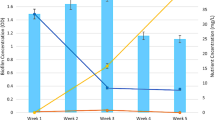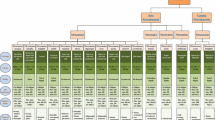Abstract
Although microbial reduction of perchlorate (ClO4 −) is a promising and effective method, our knowledge on the changes in microbial communities during ClO4 − degradation is limited, especially when different electron donors are supplied and/or other contaminants are present. Here, we examined the effects of acetate and hydrogen as electron donors and nitrate and ammonium as co-contaminants on ClO4 − degradation by anaerobic microcosms using six treatments. The process of degradation was divided into the lag stage (SI) and the accelerated stage (SII). Quantitative PCR was used to quantify four genes: pcrA (encoding perchlorate reductase), cld (encoding chlorite dismutase), nirS (encoding copper and cytochrome cd1 nitrite reductase), and 16S rRNA. While the degradation of ClO4 − with acetate, nitrate, and ammonia system (PNA) was the fastest with the highest abundance of the four genes, it was the slowest in the autotrophic system (HYP). The pcrA gene accumulated in SI and played a key role in initiating the accelerated degradation of ClO4 − when its abundance reached a peak. Degradation in SII was primarily maintained by the cld gene. Acetate inhibited the growth of perchlorate-reducing bacteria (PRB), but its effect was weakened by nitrate (NO3 −), which promoted the growth of PRB in SI, and therefore, accelerated the ClO4 − degradation rate. In addition, ammonia (NH4 +), as nitrogen sources, accelerated the growth of PRB. The bacterial communities’ structure and diversity were significantly affected by electron donors and co-contaminants. Under heterotrophic conditions, both ammonia and nitrate promoted Azospira as the most dominant genera, a fact that might significantly influence the rate of ClO4 − natural attenuation by degradation.




Similar content being viewed by others
References
Achenbach LA, Michaelidou U, Bruce RA, Fryman J, Coates JD (2001) Dechloromonas agitata gen. nov., sp. nov. and Dechlorosoma suillum gen. nov., sp. nov., two novel environmentally dominant (per)chlorate-reducing bacteria and their phylogenetic position. Int J Syst Evol Microbiol 51:527–533
Bardiya N, Bae JH (2011) Dissimilatory perchlorate reduction: a review. Microbiol Res 166:237–254
Bender KS, Shang C, Chakraborty R, Belchik SM, Coates JD, Achenbach LA (2005) Identification, characterization, and classification of genes encoding perchlorate reductase. J Bacteriol 187:5090–5096
Bruce RA, Achenbach LA, Coates JD (1999) Reduction of (per)chlorate by a novel organism isolated from paper mill waste. Environ Microbiol 1:319–329
Caporaso JG, Bittinger K, Bushman FD, DeSantis TZ, Andersen GL, Knight R (2010a) PyNAST: a flexible tool for aligning sequences to a template alignment. Bioinformatics 26:266–267
Caporaso JG et al (2010b) QIIME allows analysis of high-throughput community sequencing data. Nat Methods 7:335–336
Chao A (1984) Nonparametric estimation of the number of classes in a population. Scand J Stat 11:265–270
Charnley G (2008) Perchlorate: overview of risks and regulation. Food Chem Toxicol 46:2307–2315
Chaudhuri SK, O’Connor SM, Gustavson RL, Achenbach LA, Coates JD (2002) Environmental factors that control microbial perchlorate reduction. Appl Environ Microbiol 68:4425–4430
Choi H, Silverstein J (2008) Inhibition of perchlorate reduction by nitrate in a fixed biofilm reactor. J Hazard Mater 159:440–445
Chung J, Nerenberg R, Rittmann BE (2007) Evaluation for biological reduction of nitrate and perchlorate in brine water using the hydrogen-based membrane biofilm reactor. J Environ Eng-Asce 133:157–164
Coates JD, Achenbach LA (2004) Microbial perchlorate reduction: rocket-fuelled metabolism. Nat Rev Microbiol 2:569–580
Coates JD, Michaelidou U, Bruce RA, O’Connor SM, Crespi JN, Achenbach LA (1999) Ubiquity and diversity of dissimilatory (per)chlorate-reducing bacteria. Appl Environ Microbiol 65:5234–5241
De Long SK, Kinney KA, Kirisits MJ (2010) qPCR assays to quantify genes and gene expression associated with microbial perchlorate reduction. J Microbiol Meth 83:270–274
De Long SK, Li X, Bae S, Brown JC, Raskin L, Kinney KA, Kirisits MJ (2012) Quantification of genes and gene transcripts for microbial perchlorate reduction in fixed-bed bioreactors. J Appl Microbiol 112:579–592
DeSantis TZ, Hugenholtz P, Larsen N, Rojas M, Brodie EL, Keller K, Huber T, Dalevi D, Hu P, Andersen GL (2006) Greengenes, a chimera-checked 16S rRNA gene database and workbench compatible with ARB. Appl Environ Microbiol 72:5069–5072
Edgar RC (2010) Search and clustering orders of magnitude faster than BLAST. Bioinformatics 26:2460–2461
Faith DP (1992) Conservation evaluation and phylogenetic diversity. Biol Conserv 61:1–10
Farhan YH, Hatzinger PB (2009) Modeling the biodegradation kinetics of perchlorate in the presence of oxygen and nitrate as competing electron acceptors. Bioremediat J 13:65–78
Giblin T, Frankenberger WT (2001) Perchlorate and nitrate reductase activity in the perchlorate-respiring bacterium perclace. Microbiol Res 156:311–315
Gingras TM, Batista JR (2002) Biological reduction of perchlorate in ion exchange regenerant solutions containing high salinity and ammonium levels. J Environ Monitor 4:96–101
Haas BJ et al (2011) Chimeric 16S rRNA sequence formation and detection in Sanger and 454-pyrosequenced PCR amplicons. Genome Res 21:494–504
Gal H, Ronen Z, Weisbrod N, Dahan O, Nativ R (2008) Perchlorate biodegradation in contaminated soils and the deep unsaturated zone. Soil Biol Biochem 40:1751–1757
Herman DC, Frankenberger WT (1999) Bacterial reduction of perchlorate and nitrate in water. J Environ Qual 28:1018–1024
Heylen K, Lebbe L, De Vos P (2008) Acidovorax caeni sp. nov., a denitrifying species with genetically diverse isolates from activated sludge. Int J Syst Evol Microbiol 58:73–77
Krauter P, Daily B Jr, Dibley V, Pinkart H, Legler T (2005) Perchlorate and nitrate remediation efficiency and microbial diversity in a containerized wetland bioreactor. Int J Phytoremediation 7:113–128
Lane DJ (1991) 16S/23S rRNA sequencing. In: Stackebrandt E, Goodfellow M (eds) Nucleic acid techniques in bacterial systematics. Wiley, West Sussex, United Kingdom, pp 115–175
Li X, Yuen W, Morgenroth E, Raskin L (2012) Backwash intensity and frequency impact the microbial community structure and function in a fixed-bed biofilm reactor. Appl Microbiol Biotechnol 96:815–827
Logan BE (2001) Assessing the outlook for perchlorate remediation. Environ Sci Technol 35:482–487
London MR, De Long SK, Strahota MD, Katz LE, Speitel GE Jr (2011) Autohydrogenotrophic perchlorate reduction kinetics of a microbial consortium in the presence and absence of nitrate. Water Res 45:6593–6601
Lozupone C, Knight R (2005) UniFrac: a new phylogenetic method for comparing microbial communities. Appl Environ Microbiol 71:8228–8235
Matos CT, Velizarov S, Crespo JG, Reis MAM (2006) Simultaneous removal of perchlorate and nitrate from drinking water using the ion exchange membrane bioreactor concept. Water Res 40:231–240
Michaelidou U, Coates JD, Achenbach LA (2000) Isolation and characterization of two novel (per)chlorate-reducing bacteria from swine waste lagoons. Perchlorate in the Environment. Springer US, 271-283
Muyzer G (2004) Denaturing gradient gel electrophoresis (DGGE) in microbial ecology. In: G.A. Kowalchuk (ed.) Molecular microbial ecology manual. Dordrecht, Kluwer, pp 743–769
Nerenberg R, Rittmann BE (2004) Hydrogen-based, hollow-fiber membrane biofilm reactor for reduction of perchlorate and other oxidized contaminants. Water Sci Technol 49:223–230
Nozawa-Inoue M, Jien M, Hamilton NS, Stewart V, Scow KM, Hristova KR (2008) Quantitative detection of perchlorate-reducing bacteria by real-time PCR targeting the perchlorate reductase gene. Appl Environ Microbiol 74:1941–1944
Nozawa-Inoue M, Jien M, Yang K, Rolston DE, Hristova KR, Scow KM (2011) Effect of nitrate, acetate, and hydrogen on native perchlorate-reducing microbial communities and their activity in vadose soil. Fems Microbiol Ecol 76:278–288
Nozawa-Inoue M, Scow KM, Rolston DE (2005) Reduction of perchlorate and nitrate by microbial communities in vadose soil. Appl Environ Microbiol 71:3928–3934
Oh J, Silverstein J (1999) Acetate limitation and nitrite accumulation during denitrification. J Environ Eng-Asce 125:234–242
Oosterkamp MJ, Boeren S, Plugge CM, Schaap PJ, Stams AJ (2013) Metabolic response of Alicycliphilus denitrificans strain BC towards electron acceptor variation. Proteomics 13:2886–2894
Pielou E (1966) The measurement of diversity in different types of biological collections. Theor Biol 13:131–144
Price AL, Kryukov GV, de Bakker PI, Purcell SM, Staples J, Wei LJ, Sunyaev SR (2010) Pooled association tests for rare variants in exon-resequencing studies. Am J Hum Genet 86:832–838
Raj JRA, Muruganandam L (2012) Batch studies and effect of environmental parameters on microbial degradation of perchlorate using acclimatized effluent sludge research. J Chem Environ 16:44–50
Reeder J, Knight R (2010) Rapidly denoising pyrosequencing amplicon reads by exploiting rank-abundance distributions. Nat Methods 7:668–669
Sun Y, Gustavson RL, Ali N, Weber KA, Westphal LL, Coates JD (2009) Behavioral response of dissimilatory perchlorate-reducing bacteria to different electron acceptors. Appl Microbiol Biotechnol 84:955–963
Tipton DK, Rolston DE, Scow KM (2003) Transport and biodegradation of perchlorate in soils. J Environ Qual 32:40–46
Tran N et al (2008) Thyroid-stimulating hormone increases active transport of perchlorate into thyroid cells. Am J Physiol Endocrinol Metab 294:802–806
Urbansky ET (1998) Perchlorate chemistry: implications for analysis and remediation. Bioremediat J 2:81–95
Waller AS, Cox EE, Edwards EA (2004) Perchlorate-reducing microorganisms isolated from contaminated sites. Environ Microbiol 6:517–527
Wang C, Lippincott L, Meng X (2008) Kinetics of biological perchlorate reduction and pH effect. J Hazard Mater 153:663–669
Wang J, Soininen J, He J, Shen J (2012) Phylogenetic clustering increases with elevation for microbes. Environ Microbiol Rep 4:217–226
Wang Q, Garrity GM, Tiedje JM, Cole JR (2007) Naive Bayesian classifier for rapid assignment of rRNA sequences into the new bacterial taxonomy. Appl Environ Microbiol 73:5261–5267
Xiao Y, Roberts DJ, Zuo G, Badruzzaman M, Lehman GS (2010) Characterization of microbial populations in pilot-scale fluidized-bed reactors treating perchlorate- and nitrate-laden brine. Water Res 44:4029–4036
Xu J, Gao N, Tang Y, Deng Y, Sui M (2010) Perchlorate removal using granular activated carbon supported iron compounds: Synthesis, characterization and reactivity. J Environ Sci-China 22:1807–1813
Xu J, Trimble JJ, Steinberg L, Logan BE (2004) Chlorate and nitrate reduction pathways are separately induced in the perchlorate-respiring bacterium Dechlorosoma sp. KJ and the chlorate-respiring bacterium Pseudomonas sp. PDA. Water Res 38:673–680
Ye L, You H, Yao J, Kang X, Tang L (2013) Seasonal variation and factors influencing perchlorate in water, snow, soil and corns in Northeastern China. Chemosphere 90:2493–2498
Zhao HP, Van Ginkel S, Tang Y, Kang DW, Rittmann B, Krajmalnik-Brown R (2011) Interactions between perchlorate and nitrate reductions in the biofilm of a hydrogen-based membrane biofilm reactor. Environ Sci Technol 45:10155–10162
Acknowledgments
This research was supported by National Natural Science Foundation of China (40972162, granted to FL), Beijing Higher Education Young Elite Teacher Project (granted to XYG), and The Fundamental Research Funds for the Central Universities (2012071, granted to XYG).
Author information
Authors and Affiliations
Corresponding author
Additional information
Responsible editor: Gerald Thouand
Xiangyu Guan and Yuxuan Xie equally contributed to this work.
Electronic supplementary material
Below is the link to the electronic supplementary material.
ESM 1
(DOCX 24 kb)
Rights and permissions
About this article
Cite this article
Guan, X., Xie, Y., Wang, J. et al. Electron donors and co-contaminants affect microbial community composition and activity in perchlorate degradation. Environ Sci Pollut Res 22, 6057–6067 (2015). https://doi.org/10.1007/s11356-014-3792-9
Received:
Accepted:
Published:
Issue Date:
DOI: https://doi.org/10.1007/s11356-014-3792-9




